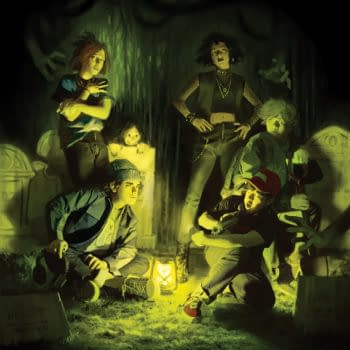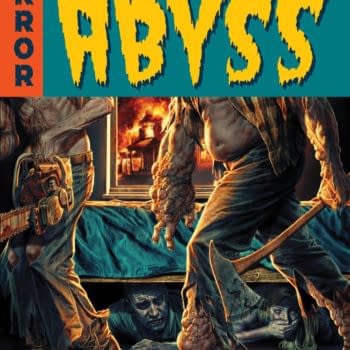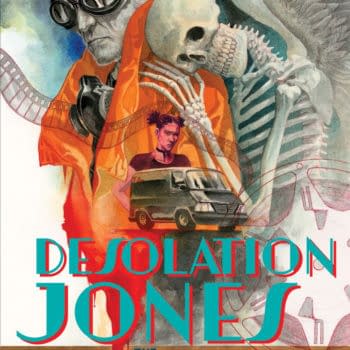Posted in: Comics, Recent Updates | Tagged: Comics, HRL, michael davis
Ghost Stories Of An Antiquary II: A Sequel Retold By Leah Moore, John Reppion, Meghan Hetrick, Al Davison, George Kambadais, And Abigail Larson
Last year, graphic novel publishers SelfMadeHero published a comic book adaptation of the short stories of M.R. James, master of the English ghost story, called Ghost Stories of an Antiquary, adapted by Leah Moore, John Reppion and friends. And an introduction by The Last Days of Jack Sparks and Doctor Who writer Jason Arnopp.
It did really, really well.
So much so that they've done it again, out for Halloween 2017.
Ghost Stories Of An Antiquary II is out, re-imagining four of his most compelling stories in graphic form including Oh Whistle and I'll Come to You, My Son, James's best-known story, about an ancient curse, and already adapted twice for BBC TV. For this volume, it has been illustrated by The Spiral Cage's Al Davison.
The other stories are Number 13, illustrated by Greece-based George Kambadais (Short Order Crooks), telling the story of a Danish historian whose research is disrupted by the mysterious occupant of a hotel room.
Count Magnus, illustrated by Abigail Larson, recounts the haunting tale of a travel writer who is obsessed with uncovering the dark secrets of the Count's mausoleum.
The Treasure of Abbot Thomas, illustrated by Meghan Hetrick, tells of an expedition to discover the Abbot's hidden gold.
You know what this means? A third volume for 2018. Well, it's a tradition now… and plenty more to come.
James's ghost stories were published in a series of collections: Ghost Stories of an Antiquary (1904), More Ghost Stories of an Antiquary (1911), A Thin Ghost and Others (1919), and A Warning to the Curious and Other Ghost Stories (1925). The first hardback collected edition appeared in 1931. Many of the tales were written as Christmas Eve entertainments and read aloud to friends.
James perfected a method of storytelling that has since become known as Jamesian. The classic Jamesian tale usually includes the following elements:
- A characterful setting in an English village, seaside town or country estate; an ancient town in France, Denmark or Sweden; or a venerable abbey or university
- A nondescript and rather naive gentleman-scholar as protagonist (often of a reserved nature)
- The discovery of an old book or other antiquarian object that somehow unlocks, calls down the wrath, or at least attracts the unwelcome attention of a supernatural menace, usually from
- Beyond the grave
According to James, the story must "put the reader into the position of saying to himself, 'If I'm not very careful, something of this kind may happen to me!'"[6] He also perfected the technique of narrating supernatural events through implication and suggestion, letting his reader fill in the blanks, and focusing on the mundane details of his settings and characters in order to throw the horrific and bizarre elements into greater relief.
He summed up his approach in his foreword to the anthology Ghosts and Marvels:
"Two ingredients most valuable in the concocting of a ghost story are, to me, the atmosphere and the nicely managed crescendo. … Let us, then, be introduced to the actors in a placid way; let us see them going about their ordinary business, undisturbed by forebodings, pleased with their surroundings; and into this calm environment let the ominous thing put out its head, unobtrusively at first, and then more insistently, until it holds the stage."
He also noted:
"Another requisite, in my opinion, is that the ghost should be malevolent or odious: amiable and helpful apparitions are all very well in fairy tales or in local legends, but I have no use for them in a fictitious ghost story."
Despite his suggestion (in the essay "Stories I Have Tried to Write") that writers employ reticence in their work, many of James's tales depict scenes and images of savage and often disturbing violence. For example, in Lost Hearts, pubescent children are taken in by a sinister dabbler in the occult who cuts their hearts from their still-living bodies. In a 1929 essay, James stated:
"Reticence may be an elderly doctrine to preach, yet from the artistic point of view, I am sure it is a sound one. Reticence conduces to effect, blatancy ruins it, and there is much blatancy in a lot of recent stories. They drag in sex too, which is a fatal mistake; sex is tiresome enough in the novels; in a ghost story, or as the backbone of a ghost story, I have no patience with it. At the same time don't let us be mild and drab. Malevolence and terror, the glare of evil faces, 'the stony grin of unearthly malice', pursuing forms in darkness, and 'long-drawn, distant screams', are all in place, and so is a modicum of blood, shed with deliberation and carefully husbanded; the weltering and wallowing that I too often encounter merely recall the methods of M.G. Lewis."
Although not overtly sexual, plots of this nature have been perceived as unintentional metaphors of the Freudian variety. James's biographer Michael Cox wrote in M. R. James: An Informal Portrait (1983), "One need not be a professional psychoanalyst to see the ghost stories as some release from feelings held in check." Reviewing this biography (Daily Telegraph, 1983), the novelist and diarist Anthony Powell, who attended Eton under James's tutelage, commented that "I myself have heard it suggested that James's (of course platonic) love affairs were in fact fascinating to watch." Powell was referring to James's relationships with his pupils, not his peers.
Other critics have seen complex psychological undercurrents in James's work. His authorial revulsion from tactile contact with other people has been noted by Julia Briggs in Night Visitors: The Rise and Fall of the English Ghost Story (1977). As Nigel Kneale said in the introduction to the Folio Society edition of Ghost Stories of M. R. James, "In an age where every man is his own psychologist, M. R. James looks like rich and promising material. … There must have been times when it was hard to be Monty James." Or, to put it another way:
"Although James conjures up strange beasts and supernatural manifestations, the shock effect of his stories is usually strongest when he is dealing in physical mutilation and abnormality, generally sketched in with the lightest of pens."
James's statements about his actual beliefs about ghosts were ambiguous. He wrote, "I answer that I am prepared to consider evidence and accept it if it satisfies me."













